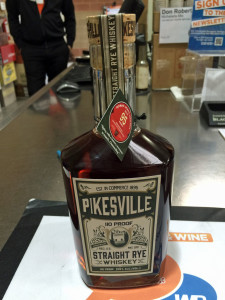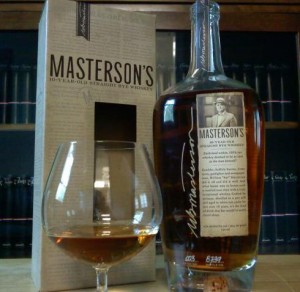Rye Whiskey 101
The Guide To “America’s Original Whiskey”
By Richard Thomas
Driven in large part by its popularity as a core cocktail spirit in the mixology boom that began a decade ago, rye whiskey has risen from bourbon’s sleepy stepsister into a lively and legitimate sector of American Whiskey. While rye has not yet revived to what it was before Prohibition, it is fair to say that when pundits speak of American malts becoming “the next big thing,” it’s what happened to rye whiskey that they have in mind. Just as fair is that you can’t really be an American Whiskey enthusiast without having some appreciation for this nearly lost category.
How Rye Differs From Bourbon
Just as bourbon whiskey is defined by Federal law as made from a mashbill with 51% or greater corn, so rye is defined as made from 51% or greater rye. The classic bourbon recipe uses rye as a flavoring element, but for rye whiskey it is the foundation. Sometimes, as described below, corn isn’t even part of the equation.
This aside, rye whiskey is identical to bourbon in every respect. The law stipulates the same maximum distillation strength (80% ABV), the same maximum strength for putting it in the barrel (62.5% ABV) and that the whiskey be aged in new oak barrels. The same requirements apply for rye whiskey to earn the designation “straight” and “bottled-in-bond” as for bourbon. The only real difference is in what grains are used to make the alcohol-bearing mash that starts the process of whiskey-making.
Rye whiskey is often called the original American whiskey because it predates bourbon, and even predates the United States. Because rye was a more common grain than corn in colonial Pennsylvania, Maryland and Virginia, that was what they chose to make whiskey with. George Washington, one of America’s biggest distillers in those days, made what today would be called white rye whiskey.
Scottish malt whisky is made from 100% malted barley for similar reasons, barley being Scotland’s staple grain and making up some three-quarters of the grain grown in modern Scotland. Corn entered the picture in a major way only as whiskey-making in American made it’s way west and south, into Kentucky and Tennessee. This farm-driven, economic basis for what distillers could use in their mashbills would come to have a major impact on the development of rye whiskey’s identity.
Monongahela Rye
When George Washington marched in 1794 at the head of a militia army to put down The Whiskey Rebellion, the place he was heading is now called Whiskey Point in Monogahela, Pennsylvania, the center of the insurrection against the whiskey tax and numerous other economic grievances. Hence Monogahela, the style of rye whiskey associated with Pennsylvania. *
Pennsylvania rye whiskey is known for its very heavy reliance on rye, in what is often a two grain mashbill. Historically the rye content for this style is thought to have been in the 80 to 90% range, with some malted barley in the mix and no corn whatsoever. The malt is there sometimes only to provide the enzymes that help break starch down into sugar so the mash can be fermented, but also sometimes to add a little flavor in place of the absent corn. In essence, Monogahela rye is a rye purists whiskey.
Old Overholt and Rittenhouse, modern rye whiskey’s two budget staples, both started as Monogahela ryes, but as a result of the vagaries of the whiskey industry came to be made in Kentucky (now by Jim Beam and Heaven Hill respectively) and ceased to be done in the Pennsylvania style. Indeed, the last Pennsylvania distillery making Monongahela rye whiskey closed in the 1980s.
Yet the Monongahela style has been making its own comeback within the larger rye revival. Although it usually isn’t identified as such, the familiar MGP 95% rye stock whiskey that serves as the basis for so many bottled rye whiskey brands (Templeton Rye, George Dickel, James E. Pepper, etc.) is certainly in the no-corn, ultra high rye in the spirit of Pennsylvania. However, it is made in Indiana and was originally developed as a flavoring whiskey for blending, and so best thought of as Pennsylvania-like.
In the Keystone State itself, micro-distilleries have been reviving the native whiskey style. Best known among them is Dad’s Hat near Philadelphia, using a mashbill of 80% rye, 15% malted barley and 5% malted rye. “The resulting flavor has upfront and center palate spice and dried fruit, with a malty sweetness on the outer edges of the tongue yielding a long, soft finish,” says John Cooper, co-founder of Dad’s Hat.
Maryland Rye Whiskey
Made just across the Mason-Dixon Line was Maryland style rye, which died out a decade before Pennsylvania rye disappeared. Little is known about the mashbill standards for this style, although by reputation it was regarded as softer and more well-rounded than the robustly spicy Pennsylvanian whiskey. Thus, it was probably lighter on the rye and used corn, akin to a reversed bourbon whiskey.

(Credit: John Rayls)
Maryland therefore lies between the Kentucky style (see below) and the Monongahela approach. Leopold Brothers in Colorado has made a Maryland-like whiskey, using a 65% rye, 15% corn and 20% malted barley mashbill. In Maryland itself, Sagamore Spirits released a rye whiskey earlier this year, blending two different distillate stocks described as high rye and low rye whiskeys. Whether either of those whiskeys corresponds to what is thought of as the Maryland style, however, could not be confirmed.
Kentucky Rye
Kentucky style rye is best thought of as barely rye whiskey, since its signature is a minimum, 51% rye mashbill. Jim Beam, Heaven Hill, Wild Turkey and Buffalo Trace are all either known or widely believed to follow the 51% rye standard in their rye whiskeys. Woodford Reserve Rye is slightly higher, at 53%. Combining the common new oak barrel aging with the high proportion of corn in the mash (routinely above one-third) makes Kentucky style rye quite close to high rye content bourbons like Old Grand-Dad.
Canadian Rye
Although the focus here is on American ryes, no discussion of rye whiskey would be complete without giving attention to Canadian rye. This is especially the case in view of how some Canadian ryes have been imported into the U.S., under both Canadian and American labels.
The terms “Canadian Whisky” and “Rye Whisky” are interchangeable in Canada, so what a Canadian might call rye would be thought of as not even close in the U.S. Here we consider whiskeys that are based on a mostly rye mashbill, but may not have been made drawing on stock aged entirely in new oak, as Canadian whisky is often a blend of whiskeys matured in both new and used barrels. That mix of new and old oak is the single most important feature separating a Canadian rye from its closest American relatives.

(Credit: S.D. Peters)
The craze for rye whiskey in the U.S. has led to a recent influx of Canadian rye brands, such as the (over) celebrated Crown Royal Northern Harvest Rye, Canadian Club 100% Rye and Lot 40. Other stocks of Canadian ryes have appeared in the form of WhistlePig and Masterson’s 10 Year Old Rye, made in Canada but bottled (and sometimes partially aged) in the U.S.
Insofar as how Canadian ryes taste against their American counterparts, August Sebastiani, President of 3 Badge Beverage, bottlers of Masterson’s, had this to say: “Masterson’s is a full bodied whiskey with complex mouth flavors leading to a smooth finish. These attributes are generated from it being 100% rye and aged for 10 years. Standard rye styles from the US can be bit warmer on the front and backend of the pallet, with lighter flavors in between.”



May I make a few comments on an otherwise excellent article?
Monongahela rye was and still is an appellation, not just a destination for Washington’s troops. Hence, Monongahela rye cannot be made in Philadelphia (Rittenhouse) or elsewhere, though “Monongahela-style” rye could be made anywhere. Malted rye was also part of some Monongahela distilleries’ mashbills.
The last true Monongahela rye distillery was Overholt, who ceased distilling in 1951. Michter’s, in Lebanon County, to the east, continued to make rye whiskey until their closure, but by then corn had become part of the mashbill.
At least some Maryland distilleries used rye-heavy mashbills. The Baltimore Pure Rye Distilling Company of Dundalk, distillers of BPR Pure Rye, used a 98% rye mashbill as of 1936. Maryland and Pennsylvania distillers routinely sold stocks across the border for filling under established labels, so how different could those whiskeys have been?
Thanks for mentioning Dad’s Hat. They are championing Monongahela-style rye like no one else.
Thanks Sam, and I appreciate it. Lately the two PA terms have been used interchangeably; I’m hardly the only writer (and this hardly the only published account) to do that. I imagine if Pennsylvania gets back to the point of being able to reestablish intra-regional distinctions, that would change.